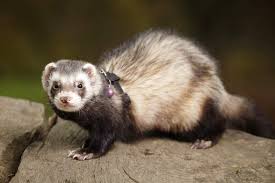
Sable Ferret
Conditions of detention
Sable Ferrets, like other ferrets, need a spacious, multi-level cage, with plenty of room to explore, sleep, and play.
Useful Fact: Sable Ferrets are highly adaptable and can thrive in various living environments as long as their basic needs are met.
Nutrition and diet
They require a diet rich in animal proteins and fats. High-quality commercial ferret food, supplemented with fresh meat, is ideal.
Useful Fact: Sable Ferrets benefit from a consistent diet and feeding schedule to maintain optimal health.
Health
Sable Ferrets are generally healthy but can be prone to common ferret health issues such as adrenal gland disease and insulinoma.
Useful Fact: Regular vet check-ups are essential to catch any health issues early, particularly those common in aging ferrets.
Grooming and care
Their dark coat is relatively easy to maintain with regular brushing and occasional baths. They also require regular nail trimming and ear cleaning.
Useful Fact: The dark fur of Sable Ferrets doesn’t show dirt as easily as lighter coats, making grooming slightly less demanding.
Education and training
Sable Ferrets are intelligent and can be trained to use a litter box, walk on a leash, and even perform simple tricks.
Useful Fact: Positive reinforcement works well with Sable Ferrets during training, making them responsive learners.
Toys and entertainment
They enjoy a variety of toys, especially ones that allow them to burrow, chase, and explore.
Useful Fact: Rotating toys regularly can keep Sable Ferrets mentally stimulated and prevent boredom.
Safety
Ensure that their environment is ferret-proofed to prevent accidents and escapes. Sable Ferrets are curious and will explore every nook and cranny.
Useful Fact: Always supervise your Sable Ferret during playtime to prevent them from getting into dangerous situations.
Accessories
Necessary accessories include a sturdy cage, comfortable bedding, a litter box, and safe, interactive toys.
Useful Fact: Investing in high-quality accessories can prolong their lifespan and improve your Sable Ferret’s comfort.
Socialization
Sable Ferrets are social creatures and thrive on interaction with humans and other ferrets.
Useful Fact: Regular playtime and handling from a young age help Sable Ferrets become well-adjusted and friendly pets.
Travel and Transportation
They should be transported in a secure, well-ventilated carrier. It’s important to make travel as stress-free as possible for them.
Useful Fact: Introducing your Sable Ferret to the carrier in a positive context before travel can reduce anxiety.
Behavior and psychology
Sable Ferrets are energetic, curious, and playful. They enjoy interacting with their environment and engaging in exploratory behavior.
Useful Fact: Providing plenty of mental and physical stimulation can help prevent behavioral issues in Sable Ferrets.
Legal aspects
Check local regulations before adopting a Sable Ferret, as ferrets are restricted in some areas.
Useful Fact: Some areas may require specific vaccinations or permits for owning ferrets, including Sable Ferrets.


